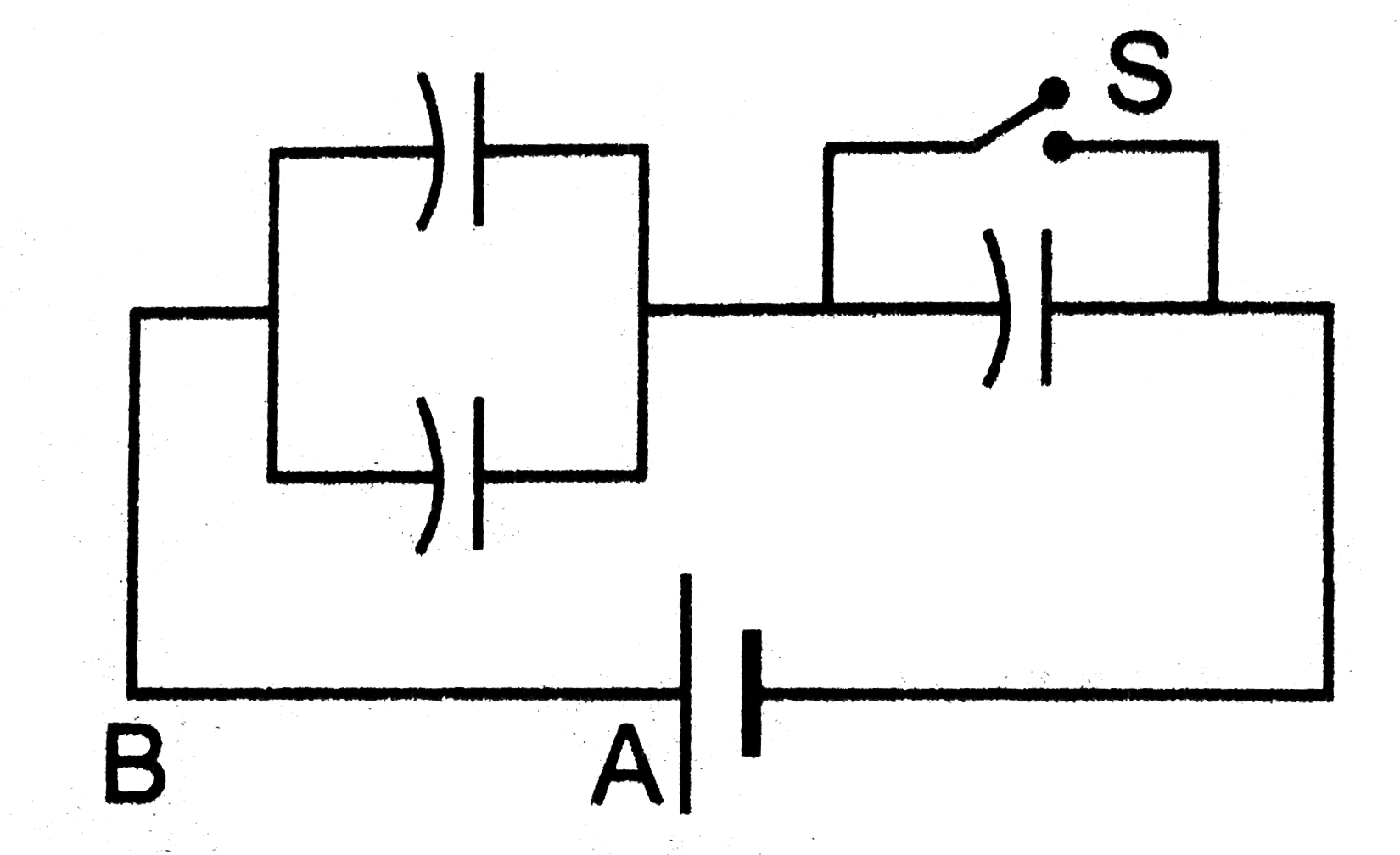The particle P shown in the figure has a mass of 10 mg and a charge of −0.01μC. Each plate has a surface area 10−2m2 on one side. What potential difference V should be applied to the combination to hold the particle P in equilibrium?

43mV
35mV
50mV
55mV
The correct Answer is:A
mg=qE, where E= electric field
or mg=qVd (where d= separation at the plates)
=qV2(∴ε0Ad=C1d=Cε0A)
or V=(2mgε)A)qC
=10−4×10×2.2×10−12×10−210−8×0.04×10−6
=10−4×9.8×8.88×10−1210−4×0.04×10−6
=43mV
Topper's Solved these Questions
- MISCELLANEOUS VOLUME 3Book:CENGAGE PHYSICSChapter:MISCELLANEOUS VOLUME 3Exercise:Multiple Correct Answer type
Explore 109 Videos
- MISCELLANEOUS VOLUME 3Book:CENGAGE PHYSICSChapter:MISCELLANEOUS VOLUME 3Exercise:Assertion and Reason Type
Explore 8 Videos
- MECHANICAL PROPERTIES OF SOLIDSBook:CENGAGE PHYSICSChapter:MECHANICAL PROPERTIES OF SOLIDSExercise:Question Bank
Explore 4 Videos
- MISCELLANEOUS VOLUME 5Book:CENGAGE PHYSICSChapter:MISCELLANEOUS VOLUME 5Exercise:Integer
Explore 12 Videos
Similar Questions
The particle P shown has amass of 10mg and a charge of−0.01μC.Each plate has a surface area

View SolutionThe particle P shown in the figure has a mass m and a charge -q. Each horizontal plate has a surface area A potential difference V=n(mgε0A2qc) should be applied to the combination to hold the particle p in equilibrium then find the value of n.

View Solution
Knowledge Check
One plate of a capacitor of capacitance 2μF has total charge +10μC and its other plate has total charge +40mUC. The potential difference between the plates is (in Volt).
A7.5B15C25D50A parallel plate capacitor has rectangular plates of 400cm2 and are separated by a distance of 2 mm with air as medium. What charge will appear on the plates. If a 200 volt potential difference is applied across the condenser
A3.54×10−6CB3.54×10−8CC3.54×10−10CD1770.8×10−13CTwo particles each have a mass of 6.0×10−3 kg. One has a charge of +5.0×10−6 C. and the other has a charge of −5.0×10−6 C. They are initially held at rest at a distance of 0.80 m apart. Both are then released and accelerate toward each other. How fast is each particle moving when the separation between them is one-third its initial value?
A7.3 m/sB3.9 m/sC9.7 m/sD5.4 m/s
Lower plate of a parallel plate capacitor is fixed on a horizontal insulating surface. The upper plate is suspended above it using on elastic cord of force constant K. The upper plate has negligible mass and area of each plate is A. When there is no charge on the plates the equilibrium separation between them is d. When a potential difference = V is applied between the plates the equilibrium separation changes to x.
(a) Calculate V as a function of x.
(b) Find the value of x for which V is maximum. Calculate the maximum value of V(=Vmax)
(c) What will happen if V>Vmax ?
(d) Plot a rough graph showing variation of equilibrium separation (x) with V

View SolutionA parallel air capacitance 245μF has a charge of magnitude 0.48μC on each plate. The plates are 0.328mm apart.
(a) What is the potential difference between the plates?
(b) What is the area of each plate?
(c) What is the surface charge density on each plate?
View Solution
Particle P shown in figure is moving in a circle of radius R=10 cm with linear speed v=2m/s Find the angular speed of particle about point O.
View SolutionAn infinite sheet of charge has a surfaces charge density of 10−7Cm2. The separation between two equipotential surfce whose potentials differ by 5V is
View SolutionA charged particle having charge 10−6 C and mass of 10−10 kg is fired from the middle of the plate making an angle 30∘ with plane of the plate. Length of the plate is 0.17m and it is separated by 0.1m. Electric field E=10−3NC is present between the plates. Just outside the plates magnetic field is present. Find the velocity of projection of charged particle and magnitude of the magnetic field perpendicular to the plane of the figure, if it has to graze the plate at C and A parallel to the surface of the plate. (Neglect gravity)

View Solution